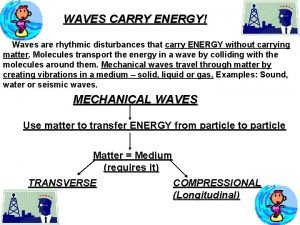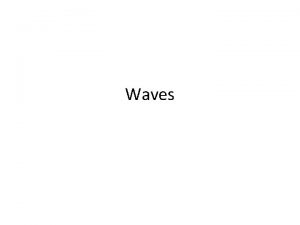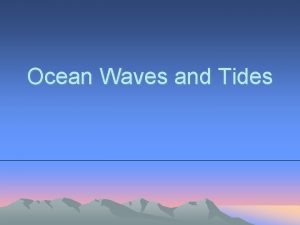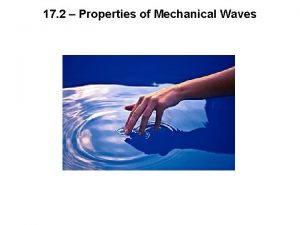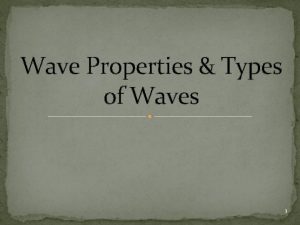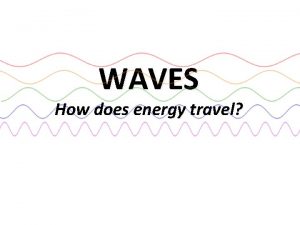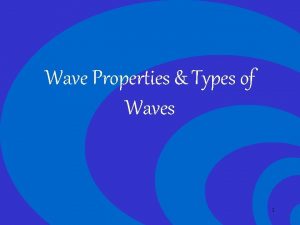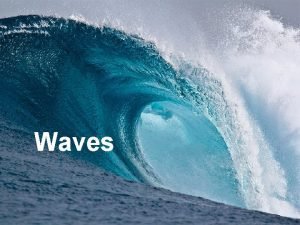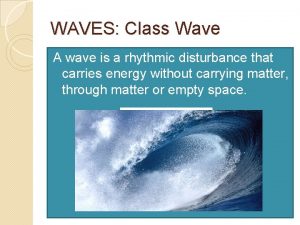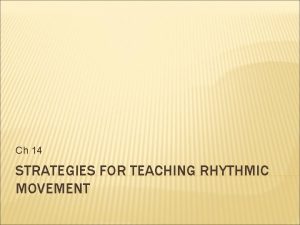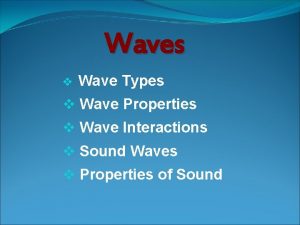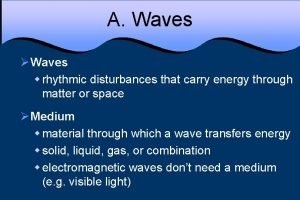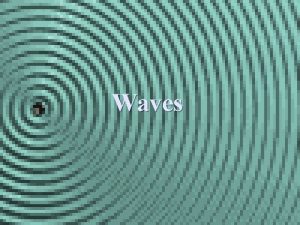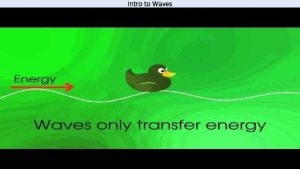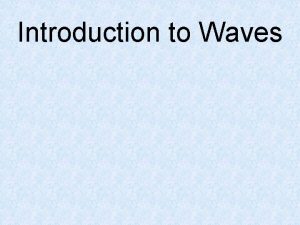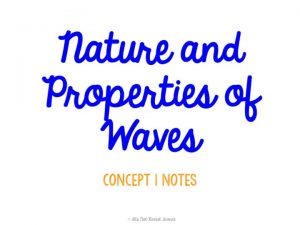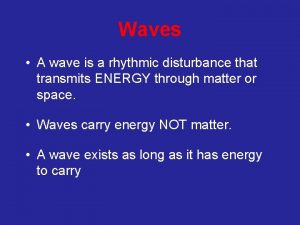Wave Properties Types of Waves 1 Wave Rhythmic






















- Slides: 22

Wave Properties & Types of Waves 1

�Wave - Rhythmic disturbance that carries energy through matter and space �ALL WAVES CARRY ENERGY! �Pulse – one wave that travels through a medium �Continuous waves – waves that repeatedly move up and down 2

Medium �Most waves need something to travel on (or through) �The substance through which a wave travels is a medium 3

�Amplitude (A) maximum displacement of a particle from rest or equilibrium position. Measure in units of length �Phase related to the position and motion of the particles of the medium 4

Period and Frequency �Period (T) – time it takes for one wave to pass �The unit of a period is the second (s) �Frequency (f) – the number of waves that pass each second �The unit of frequency is Hertz (Hz) 5

Velocity - the speed of the wave denoted by v and measured in units of dist/time The speed of a wave depends on the properties of the medium through which it is traveling. v = d/t = l/T = f l

Formula 1 �Frequency = 1/ period �f = 1/T 7

Formula 2 �Frequency = # waves / time �f = # waves / t 8

Formula 3 �Velocity= frequency x wavelength �v = f x λ or λ/T 9

Transverse Waves �Transverse waves – matter in the medium moves back and forth at right angles to the direction that the wave travels. 10

Parts of a Transverse Wave �Crest – top of a wave �Trough – bottom of a wave 11

Parts of a Transverse Wave �Amplitude – ½ the height of a wave �Relates to the amount of energy carried by the wave 12

Parts of a Transverse Wave 13

Parts of a Transverse Wave �Wavelength – the length of one cycle of a wave �Abbreviated by using the symbol, λ 14

Transverse Wave �Frequency – how many cycles (waves) are completed in a given time (usually 1 second) 15

Compression/ Longitudinal Waves �Compressional waves – matter in the medium moves in the same direction that the wave travels. Example: Sound waves 16

Parts of a compression wave Compression – the area where the particles are more dense 17

Parts of a compression wave Rarefaction – The less dense area of the wave 18

Parts of a compression wave Wavelength – One complete cycle of a wave 19

Surface Waves �both transverse & compressional; �examples: water waves, seismic waves 20

Standing Waves �Appear to be standing still �Standing waves are caused by two waves continuously interfering with each other. 21

Types of Waves… 22
 Waves are rhythmic disturbances that carry
Waves are rhythmic disturbances that carry Waves are rhythmic disturbances that carry
Waves are rhythmic disturbances that carry A rhythmic disturbance that carries energy
A rhythmic disturbance that carries energy Describe the rhythmic movement of a wave
Describe the rhythmic movement of a wave Mechanical waves and electromagnetic waves similarities
Mechanical waves and electromagnetic waves similarities Light is electromagnetic wave true or false
Light is electromagnetic wave true or false Similarities of mechanical and electromagnetic waves
Similarities of mechanical and electromagnetic waves How are rainbows made
How are rainbows made What type of waves are sound waves? *
What type of waves are sound waves? * Whats a reflected sound wave
Whats a reflected sound wave What is a semiconductor used for
What is a semiconductor used for Mechanical waves and electromagnetic waves similarities
Mechanical waves and electromagnetic waves similarities Electromagnetic waves vs mechanical waves
Electromagnetic waves vs mechanical waves Mechanical and electromagnetic waves similarities
Mechanical and electromagnetic waves similarities Seismic waves
Seismic waves Seismic waves are mechanical waves
Seismic waves are mechanical waves Compare and contrast p waves and s waves using venn diagram
Compare and contrast p waves and s waves using venn diagram Mechanical and electromagnetic waves
Mechanical and electromagnetic waves Difference between constructive and destructive waves
Difference between constructive and destructive waves Kesler science
Kesler science 4 basic properties of waves
4 basic properties of waves What are measurable properties
What are measurable properties Properties of mechanical wave
Properties of mechanical wave

